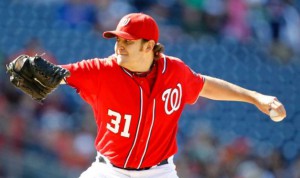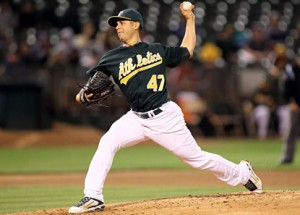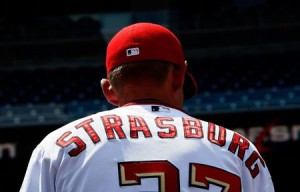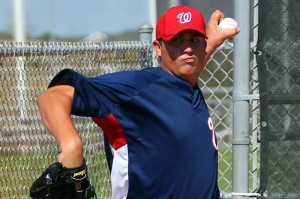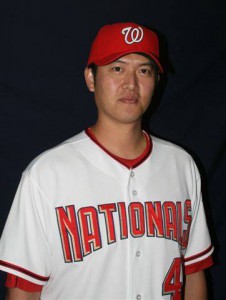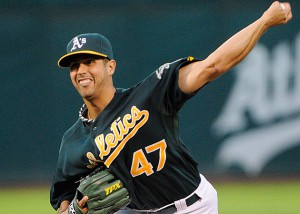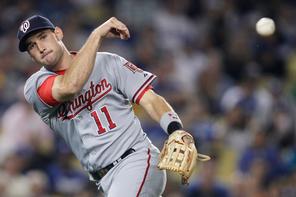I was sort of curious why there was so much volume on my Nationals RSS feeds this morning; little did I know there was a relatively shocking piece of news to report and comment on; John Lannan has been optioned to AAA to start the 2012 season.
I’ll admit it: I had Lannan penciled in as the 5th starter as soon as Chien-Ming Wang went down with injury. I didn’t give it a second thought. When the Nats bought Edwin Jackson, they had 6 starters for 5 spots and my presumption was that Lannan was the default choice for the 5th starter once Wang proved not to be ready for the start of the season. In the back of my mind I knew Lannan had an option … but never thought that he and his $5M salary would be dropped to Syracuse.
This action definitely sends some statements. In no particular order:
1. Unlike past iterations of the team (notably the 2009 team and the bullpen construction decisions made at the end of spring training), this sends the message that roster spots are not entirely guaranteed by virtue of salary or options status. We all knew Ross Detwiler had no options and was set to make the 25-man roster, but nobody thought he’d be beating out Lannan for the 5th starter spot. Its hard to argue he didn’t earn it; his Spring Training ERA was half that of Lannan’s.
2. The team isn’t concerned about “wasting” salary: Lannan joins fellow multi-millionare Yuniesky Maya in Syracuse, meaning that the Syracuse rotation is set to earn a sizeable percentage per annum of the major league rotation (roughly $20M for the Nats starting 5 versus $7M and change in AAA). In fact if it weren’t for Jackson’s $11M salary the two rotations would be roughly equal. Amazing.
3. Was there a stated rotation competition still ongoing this late into Spring Training? If so it certainly didn’t come out in the dozens of stories filed by the beat reporters from Viera. Perhaps the real shock here is that nobody knew that Lannan’s job was in jeopardy. Did Lannan?
4. Sending Lannan down isn’t the same thing as sending Bryce Harper down: I’ve seen some bloggers kvetching about the statement “we’re starting with our best 25” when explaining the demotion while the team breaks camp with 3 non-roster invitees (Tracy, Carroll, Nady), at least one of which is set to get major reps in the outfield, and none of which are as good as Harper right now. The simple matter is this; there’s “money” considerations and then there’s “MONEY” considerations. Just keeping Harper in the minors a couple of weeks guarantees us one more year of his service prior to FA eligibility, and that’s hugely important. No-one will argue the WAR-value add of 2 weeks of a 19yr old rookie versus 162 games of a 25-yr old emerging slugger.
I can buy some of the argument, by the way, that the Super-2 status concerns may be moot with Harper, considering that the team is in its best interests to buy out Harper’s arbitration years before he hits them. Other forward-thinking teams (Tampa, Colorado, Los Angeles, Milwaukee) have certainly been doing this with their younger stars (Evan Longoria, Matt Moore, Troy Tulowitzki, Matt Kemp, and Ryan Braun respectively for the above teams). But, as far as I can tell none of the above players are advised by Scott Boras, who knows maximum value is obtained by waiting til the last minute, by playing all the angles, and by not giving “home town discounts.” So for me, there is still significant future value in keeping Harper in the minors until mid-to-late June. The difference can be googled by the reader, as WP writers have done this analysis several times in the past and discovered that a superstar avoiding super-2 can mean $14-$18M in future salary.
5. Davey Johnson needs to get on the same page as his boss (aka, Mike Rizzo). Johnson telling the press “John’s my guy,” as he reportedly did just last week, or Johnson prematurely announcing that Lannan had won the 5th starter spot and then revoking it is a serious breach of boss-employee trust. No wonder Lannan “took the news hard;” how would you feel if you were blindsided by your employer a week after them telling you that you were doing a great job and that everything seemed fine? In this respect, the team seemed to have done Lannan wrong. I’ll caveat this by saying that none of us armchair pundits are in the clubhouse on a day to day basis, so none of us had any idea what conversations Johnson and Lannan may have had leading up to his demotion.
6. I will have to agree with others who think this sends a bad message to the rest of the team. Lannan by all respects is the kind of player teams want. He doesn’t make waves, he doesn’t get bad press. He was our opening day starter twice in recent years, he was a great example of a middle-round player overcoming his draft position and potential to make the majors, and he frankly isn’t that bad a pitcher. Does the team’s “treatment” of Lannan send the wrong message to its veterans? If so, that’s a bad cloud to have hanging over a team with some serious money tied up with its veterans (namely Werth, Zimmerman and Gonzalez). If these guys didn’t like the way the team handled this situation, the clubhouse could be lost fairly easily.
7. You would think this action kills what remaining trade value Lannan had; Rizzo had already spoken of how the trade market for him was “thin” to begin with. Lannan is a tough asset to get equal value for; he doesn’t over power you, he has unimposing stats (career 101 ERA+, or exactly MLB average), and he doesn’t get a ton of Ks. He is a durable lefty who can fit at the back of your rotation. Is that worth $5M a year (and more next year when he hits arbitration again)? Or, more importantly to the Nats, is that worth a starting position player? Certainly the Angels aren’t giving up their promising CF Peter Bourjos (as an example) for Lannan straight up. We’d have to sweeten the pot. Except that at some point, the value of keeping a disgruntled Lannan in AAA as starter insurance will eventually be more important than whatever role player we could get in return.
The one precedent that gives me hope on the trade front is when the team somehow turned demoted and malcontented Lastings Milledge into Nyjer Morgan (yes I know there was two others involved, but in terms of like for like, Milledge essentially turned into Morgan). Perhaps Detwiler will continue his late 2011 performance into April of 2012 and will remain our starter-in-waiting to cover for eventual injuries and what not. This would give the team more confidence to shop the now-insurance policy Lannan and wait for the right deal.
All in all, just your ordinary Wednesday in Nats town.
